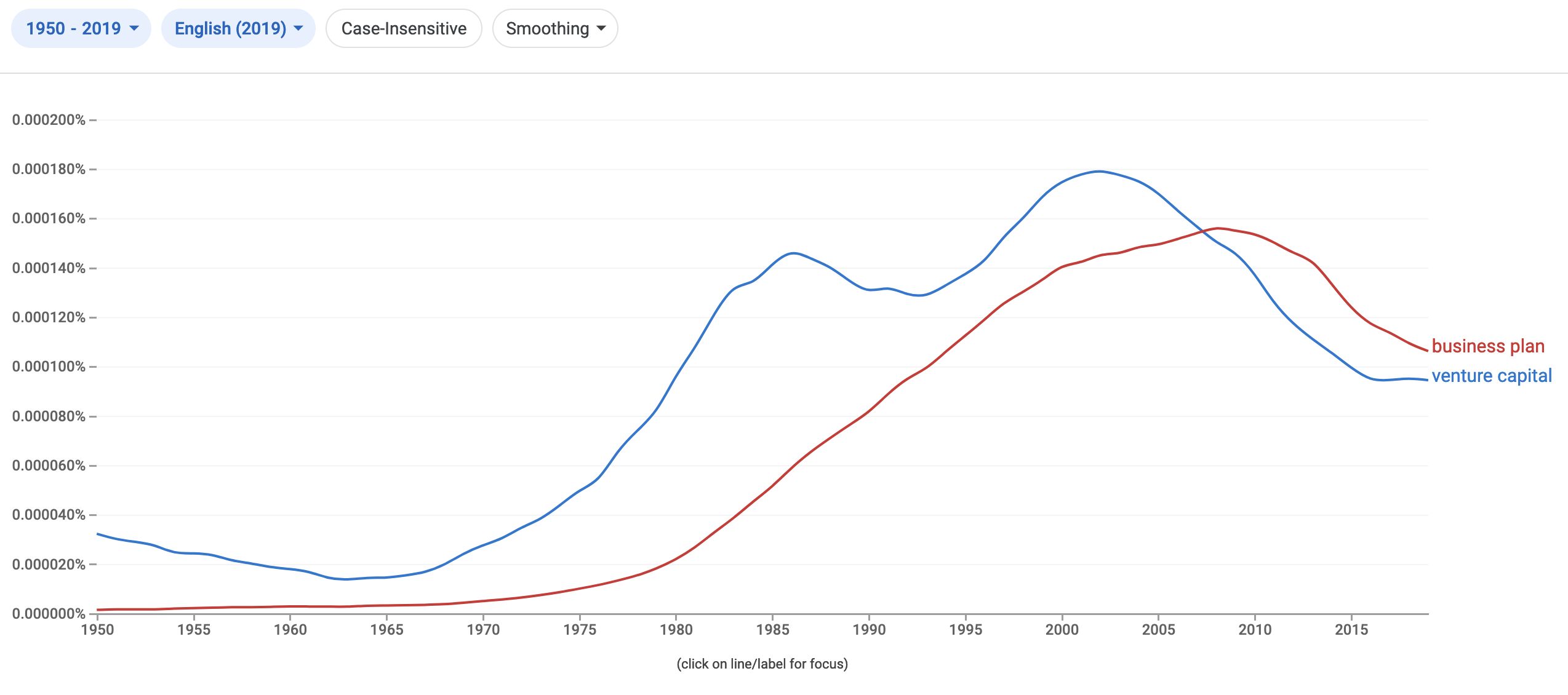The powerful forces of nature have brought change since the beginning of time. Specifically, technological change has brought us great benefits and great opportunities – even if it is hard to predict how things will develop! This topic will take a look at change, predictions and plans.
Welcome to Topic 3: Startups Are Hard... In this topic, you will learn about:
- Change, predictions, plans and how we think
- The strong forces at work
- Causation, Causality and Correlation
- Maps, plans and searching from scratch
- Create and transform for society.
These relate to the Subject Learning Outcomes:
- Identify the forces of change in our increasingly globalised and complex world which put new demands on entrepreneurs.
- Recognise the sobering statistic of business failures, while understanding the learning value of such experiences.
Welcome to your pre-seminar learning tasks for this week. Please ensure you complete these prior to attending your scheduled seminar with your lecturer.
Click on each of the following headings to read more about what is required for each of your pre-seminar learning tasks.
Read the following sections of the text, Read, S, Sarasvathy, S, Dew, N & Wiltbank, R 2016, Effectual Entrepreneurship, 2nd edn., Routledge.
- Chapter 7, pp. 72-81: Opportunities are created as well as discovered
- Chapter 19, pp. 221-236: Business plans and business models
- Chapter 23, pp. 277-288: Entrepreneurship as technology for social change.
Identify the key takeouts from each of the readings and add these to your reflective journal. You can access the reflective journal by clicking on ‘Journal’ in the navigation bar for this subject.
Read the following academic articles and take notes in your reflective journal.
- Dew, N, Read, S, Sarasvathy, SD & Wiltbank, R 2010, 'On the entrepreneurial genesis of new markets: Effectual transformations versus causal search and selection', Journal of Evolutionary Economics, 21(2):231-253.
- Bhowmick, S 2011, ‘Effectuation and the dialectic of control,’ Small Enterprise Research, 18(1); 51-62.LMS
Read and watch the following content.

Change, predictions, plans and how we think
Perhaps only someone completely shut off from the modern world and deep in the forest would dismiss the idea that the world around us is constantly changing.
As we learned in Topic 1, uncertainty due to change makes predicting the future difficult. Yet as humans, we love to predict and plan out how to reach our goals based on the predictions. Predictions are at the core of the traditional business plan. Despite the amount of effort put into developing business plans, including considering various contingencies, statistics show that startups are hard, and many fail. Some people react to failure with the belief they need to plan better. However, it can be useful to question whether the logic underpinning business plans, namely causal logic (also known as cause and effect), is the best approach. Another factor is the notion that 'the map is not the territory'. In other words, that even the most detailed plan cannot exactly mirror the reality that will eventuate.
We will also question whether the 'search and select' approach to identifying and pursuing the best business opportunity is the best way to go about things. Research shows that very successful entrepreneurs do not seek out the best opportunity. Instead they use what they already have to create an opportunity and develop it over time. This is called the 'create and transform' approach.
Learning task 1: Questions before we get started
In this topic, we look at how relying on predictions in a rapidly changing world is one of the factors contributing to a relatively low success rate of new ventures.
Consider the following questions:
- Are you someone who prefers to ‘take things as they come’, or do you feel more comfortable preparing extensively and planning things out?
- Have you ever made a grand plan for something that ended up developing in an unexpected way? If so, describe what happened and why you think it turned out like that.
- What do you think of the idea from author Alan Lakein (n.d.), "Failing to plan is planning to fail"?
Write your responses in your reflective journal.
Learning task 2: Anonymous poll
To get an idea of where people are on the idea of starting a business one day, please respond to the following poll.
After you have submitted your response, you can see how others have responded by clicking on the link, "See previous responses".
Strong forces at work
Let us take a look at changes and the role of business plans.
Change is pervasive
Change is pervasive and seems to be speeding up as the Canadian Prime Minister, Justin Trudeau, argues:
The pace of change has never been this fastJustin Trudeau 2018
Looking intently at the world of work, Blank (2013) stated in the article 'Why the lean start-up changes everything’:
"Today the forces of disruption, globalization, and regulation are buffeting the economies of every country. Established industries are rapidly shedding jobs, many of which will never return. Employment growth in the 21st century will have to come from new ventures, so we all have a vested interest in fostering an environment that helps them succeed, grow, and hire more workers. The creation of an innovation economy that’s driven by the rapid expansion of startups has never been more imperative."
Since that article was published, Steve Blank has been observing change. In the following video of his speech at the graduation ceremony of Dalhousie University in Nova Scotia, Canada, he shares his insights on the history of change and how each wave of technological change affected how people of that era thought. You will know from personal experience how technology (particularly the smartphone) has changed your behaviour. The new generation holds a key in the unknown future.
With the insightful bridge that Steve Blank has given us from the history into today's world of racing change, let us look a little more closely at the roles of humans in this technological future.
Watch the following video of futurist keynote speaker, Gerd Leonhard.
You might remember that there was a mention of change bringing opportunities at the beginning of this section. We all might understand this theoretically, but let us get practical.
Imagine you are a person who wants to harness technology; a visionary with ideas about the direction things will take; and some ideas about business opportunities. That is what Australian expatriate Tim Kentley-Klay and American Jesse Levinson of Zoox, a company focused on autonomous vehicles, are doing.
Kentley-Klay and Levinson are taking a specific business approach called ‘stealth mode’, in which they keep their work secret, mainly for competitive reasons. This means they predict how the market might change over time, develop plans and technology, and are very careful about sharing information outside of their company.
Watch the following video of their interview with Professor Tina Seelig of Stanford University.
Learning task 3: Video reflection
Based on Tim's reply to Tina's questions “Why is it you are in stealth mode?” and “Why are you choosing not to tell us what this experience will be like?” [from 9:45], take a moment to reflect and complete Topic 3: Forum Activity 1. You can also navigate to the forum by clicking on 'ENT101 Subject Forum' in the navigation bar for this subject.
The best-laid plans
The saying, "the best-laid plans of mice and men often go awry" comes from the poem To a Mouse by Scottish poet Robert Burns (1759-1796) (Dictionary.com n.d.).
Even in the 1700s, it was understood that planning is difficult. In today’s world, it certainly is no easier. This means that while you might put together a detailed plan for your business idea, it does not mean it will necessarily go as planned.
Traditional business plans – a relatively new tool
There does not appear to be a definitive history of business plans. However, an interesting search engine called Google Books Ngram Viewer (n.d.), can be used to see the frequency of use of the terms, “business plan”, “venture capital” and “entrepreneurship” in books. The following figure shows the term “business plan” became widespread between the 1980s and 1990s.

Check out Google Books Ngram Viewer (n.d.) yourself by searching for the words “business plan” and selecting “1950-2019”.
Typical contents of business plans
To get a sense of what most people expect to find in a business plan, watch the following video, How to write a business plan, by Business Wales, an organisation that helps people start businesses.
It all sounds so simple...
This is not a critique of Business Wales, nor any other person or organisation convinced of the power of business plans (which were considered the standard for 40-50 years). Still, the idea of basing an entire business on a series of assumptions could explain why we are witnessing such high failure rates among startups.
In the next section, we will take a closer look at the dangers of confusing causation and correlation. However, for now, let us listen to Steve Blank's take on things in terms of how the traditional business plan is really rather flimsy. Watch the following video, which is aptly titled, No business plan survives first contact with customers.
Startups are hard
Not continuing a business – is that failure?
As much as there are plenty of stories about businesses closing their doors for the last time, the assumption that this development is negative, is incorrect. Let us look at the Global Entrepreneurship Monitor (GEM) perspective.
In the GEM 2016/2017 Global Report (the most recent data for this analysis), the authors go to great lengths to explain that "business discontinuation" (no longer operating) can be due to many different reasons, both negative and positive:
"It must be noted that the interpretation of the business discontinuation rate is often highly contextualised – a high rate could indicate low levels of preparations for venturing (capabilities, wrong perceptions about an opportunity, low level of motivation, etc.). A low rate, on the other hand, is not necessarily a positive indicator as entrepreneurs may be stuck in “dead” ventures because of complicated exit regulations, taxation policy, etc. The reasons for business discontinuance are many and varied. Some reasons could be seen as positive, such as the opportunity to sell, pursuing another opportunity or planned retirement. On the other hand, discontinuation may be due to lack of business profitability, problems with accessing finance and running out of working capital” (GEM 2017, p.25).
The following figure illustrates some of the reasons for discontinuing businesses for the three economic development levels. The data is from Global Entrepreneurship Monitor 2017 report and shows the percentage of entrepreneurs or owner-managers who discontinued their business.
So, as much as we cannot judge whether the reasons given are positive or negative, we can surmise that at least a third of businesses investigated by GEM discontinued due to a lack of profitability. That gives us a sense of how difficult it can be to find a profitable business model.

Business survival in Australia
Keeping GEM's work in mind and zooming in on Australia, the Australian Bureau of Statistics (2021) offers a sense of the survival rate of businesses that were started in the 2016-2017 financial year. The following figure shows that, after one (1) year, about 87 % of the businesses had continued operating. After four (4) years of operation, almost 65 % of businesses were still operating. Again, we do not have the reasons for ceasing operations, but we know that approximately a third of registered Australian businesses did not make it to the fourth "birthday".
Reasons for and success in failure
You probably do not need any more statistics to convince you of the idea of a startup being hard and that many entrepreneurs have to abandon their ‘best-laid plans’. Watch the following video, in which real entrepreneurs discuss their experiences with failure.
Do not assume that abandoning a venture is necessarily a bad thing. There is always something to be learned. Watch the following video from the Wall Street Journal, in which three (3) attendees of a ‘war stories’ conference in Hong Kong discuss what they learned when their startup failed.
Now that you have listened to a couple of ‘failed’ entrepreneurs, watch the following video to get the perspective of Dave McClure, a Silicon Valley venture capitalist who was a guest featured at a Startup Grind event in Palo Alto. Dave speaks about finding the small successes within a failure and understanding that there is no such thing as an 'overnight success’. You have to pace yourself and be in it for the duration.
Growth constraints on startups
Taking the idea of reasons for failure a bit further, are there also reasons why startups do not grow? Blank (2013) stated that "In the past, growth in the number of startups was constrained by five factors in addition to the failure rate:
- The high cost of getting the first customer and the even higher cost of getting the product wrong.
- Long technology development cycles.
- The limited number of people with an appetite for the risks inherent in founding or working at a startup.
- The structure of the venture capital industry, in which a small number of firms each needed to invest big sums in a handful of startups to have a chance at significant returns.
- The concentration of real expertise in how to build startups, which in the United States was mostly found in pockets on the East and West coasts. (This is less an issue in Europe and other parts of the world, but even overseas there are geographic entrepreneurial hot spots)".
Learning task4: Reflection
What does this mean for you?
Based on all this talk of business discontinuation, failures, war stories, constraints and the like, complete Topic 3: Forum Activity 2.
Causation, causality and correlation
There is comfort in knowing that the letter 'D' comes after 'C' and before 'E' in the English alphabet. But can we be sure that taking action can always have the same outcome? Do we consciously think about that logic? What is it called?
The Society for Effectual Action (2018), defines causation as “the focus on achieving a desired goal through a specific set of given means. Causation invokes search and select tactics and underlies most good management theories. Causal thinkers believe that “If I can predict the future, I can control it.””
In other words, the traditional approach of developing a business plan is based on a framework of assumptions to reach strategic goals is most effective in slowly evolving, locally-focused and predictable business environments. That, of course, is problematic when you consider our constantly changing world.
We will delve deeper into the uses of causation later in this subject. However, for now, let us move on to the next C – namely ‘causality’.
Causality versus correlation
Causality is one of the real dangers in causal logic because sometimes it is confused with correlation.

Maps, plans and searching from scratch
What fun it is to go on a treasure hunt! The excitement of maybe, just maybe, discovering hidden valuables. The treasure map will lead us right to the destination, right? Not necessarily! And what does this have to do with entrepreneurial thinking?
The map is not the terrain. A business plan is merely a map; it's not supposed to detail every nuance of what your venture is doing.Read et al. 2016, p.226
Watch the following video to go a little deeper into why solely relying on the map can cause problems.
Business plans in the real world
If business plans are maps and maps are not necessarily always useful, it would be natural to question what is going on in the real world. Do founders of companies really write business plans?
It is often said that before launching a company, a business plan is needed. Bartlett (2002) indicated that research on founders of firms in the Inc. 500 concluded that only 40 % of the firms in the sample had created a business plan. From the group that had created a plan, 65 % said they were doing something significantly different from their original idea. A total of 12 % of the sample indicated they were doing formal market research before launching their firms.
Amar Bhidé’s (2000) research is consistent with Bartlett’s (2002) research, indicating that 41 % of founders had no business plan at all, 26 % had a basic plan, and 28 % had a formal business plan. Do you think Bill Gates, Sam Walton and Jan Wenner had a business plan? None of them did (Read et al. 2016).
Keep in mind that a business plan is a tool to help you get started. If it is not serving you, move on without it.
'Search and select' versus 'create and transform'
The common belief is that entrepreneurs find a brilliant opportunity that nobody else had previously seen, in a light bulb moment. With this belief, it is natural to go out into the world to search out opportunities, evaluating their attractiveness and selecting one to work with. This requires, of course, a lot of market data and a relatively predictable future. Once the decision has been made to select a specific opportunity, a plan is devised to tap into the perceived potential, outlining the steps to the goal. However, to put their plan into action, the entrepreneur needs to acquire the necessary resources. Then, they can put the plan into action once this has happened. This is known as the ‘search and select’ methodology.
An alternative perspective is that opportunities are made. This happens when there is no market data available or it is unclear, making defining the market and making predictions impossible. This uncertainty forces the entrepreneur to experiment, only risking what they can afford to lose and usually working with others. This ‘create and transform’ method is also called effectuation. Effectuation will be the focus of some of the later topics in this subject.
The differences between the two (2) approaches are described in the following table:
| The approach | The market | The logic | The heuristics |
|---|---|---|---|
| Search and select | Markets are fixed. Part of any given market may be served, underserved, or latent. | Explore a finite set of possibilities to find unserved, underserved, or latent areas of the market. |
Causation Predict to identify a goal. Focus is on achieving that goal by accumulating the necessary means. Surprises are bad. |
| Create and transform | Markets can be created. Creation can be intentional or an unanticipated consequence of people just doing things they think are possible and worth doing. | Knowing it is possible to create demand, let interactions give rise to an infinite set of possibilities, which can then be prioritised by self-selected stakeholders. |
Effectuation Start taking action. Focus is on transforming a set of evolving means to generate goals that emerge along the way. Surprises are good. |
Fixed menu versus combining ingredients on hand
You can think of the two approaches using the following food-based similes. The ‘search and select’ approach is like going to a food court, reviewing the menus and selecting your meal based on your preferences.

The ‘create and transform’ approach is more like cooking a tasty meal based on the ingredients available at the market, your cooking skills as well as your preferences and those of whoever else you are cooking for.
Learning task 5:
Consider the Indian restaurant example from Read et al. (2016, pp. 78-79).
In what ways are the two (2) entrepreneurial approaches different when establishing a new Indian restaurant?
Can you think of other examples or hypotheticals of how the two (2) approaches might apply in real-life ventures?
A real-life example of a college drop-out and calligraphy
When Steve Jobs took a calligraphy course purely out of interest, it gave him skills he could never anticipate he would use, let alone skills that would make him famous. Watch the following video of Steve Jobs' 2005 Stanford Commencement Address for more detail.
Steve Jobs collected dots to create new things and transform the world.
Create and transform for society
'Create and transform’ can lead to unexpected places...
As we have learned, entrepreneurship seldom resembles the ‘fairy tale’, Silicon Valley image often found in popular media. It is not necessarily the ‘search and select’ person with a business plan in hand, but rather a regular person who sees a problem and seeks to find a solution by 'creating and transforming' – be that solution one which is driven by profit or the desire to help others.
The following short video is an excellent example of Muhammad Yunus, a teacher who 'fell' into entrepreneurship when he sought a solution to a social problem. He created and transformed the banking for the poorest of the poor. Importantly, Muhammad Yunus did not ‘search and select’ to start a bank (a causal goal) and had no business plan. However, he ended up being awarded the Nobel Peace Prize!
Is entrepreneurial motivation binary?
This leads us to question the motivation of an entrepreneur to create and transform. Is it always just to make money? In the case of Muhammad Yunus, the motivation was not for profit, but rather for social good.
Many people think that social entrepreneurship is a relatively new idea. Although the term social entrepreneur was coined in the 1970s by Bill Drayton (Dayton n.d.), the concept is not new. Let us listen to Harvard University professor Nancy Koehn, share some of her favourite historical and more modern socially-minded entrepreneurs (Koehn n.d.).
Josiah Wedgwood was the quintessential social entrepreneur. In order to better serve his customers, he was instrumental in getting a canal built (which later greatly supported local trade); set up in-house training for artisans; and oversaw a number of technical and scientific advances (Britannica n.d.). In fact, his wealth funded the scientific discoveries of his grandson, Charles Darwin (Britannica n.d.). Watch the following BBC video, which discusses Josiah Wedgwood in more detail.
Unexpected places and unexpected consequences
This section began with the idea that creating and transforming can take you to unexpected places and have unintended consequences, as Blake Mycoskie found out when he developed the now legendary "one-for-one" concept. His desire to provide shoes to poor children ended up creating a very respected brand. Watch the following video to learn more about TOMS and its founder, Blake Mycoskie.
Which approach would suit you?
All the previous examples illustrate how entrepreneurial energy can benefit all parts of society. They also demonstrate how embarking on a 'create and transform' journey can lead to unexpected and often unpredictable results. The typical causal logic-driven business plan approach (or 'search and select' approach) sets out to reach a specific goal. However, the dynamic nature of our world often forces the business planner to change their approach over time. For unwavering entrepreneurs who will not give up on their original selected goal, it can mean having to give up completely.
Learning task 6: Anonymous poll
Now that you have had a brief introduction to the 'create and transform' approach, share your natural preference in the following anonymous poll.
After you have submitted your response, you can see how others have responded by clicking on the link, "See previous responses".
Wrap up
You have been on a bit of a journey, starting with the changes around us and how those changes make planning difficult. This difficulty is reflected in someone seeking to turn their idea into a viable business. Reality will always be at least slightly different from even the best predictions. When things do not go well, most of us tend to seek to plan better, to better map out our future pathway. However, there is an alternative to seeking out the best opportunity. You can create opportunities using what you already have within your control. This approach, starting with today and working forward, is called effectual logic.
Key Takeouts
Congratulations, we made it to the end of the topic! Some key takeouts from Topic 3:
- Although change is constant, the increasing speed of technological change has affected human behaviour. This change creates new opportunities for entrepreneurs.
- Although the planning process is valuable, business plans are based on assumptions and predictions to reach a desired outcome. This is causal logic and, in an ever-changing world, can be problematic.
- Put in other terms, a business plan is a type of map and cannot accurately predict all that the entrepreneur will encounter in their startup journey.
- The difficulty of making a business idea work is reflected in relatively high new business failure rates. For startups that survive, growing the business is not easy due to high costs, hesitant customers, and limited finance and entrepreneurial expertise.
- A common belief is that entrepreneurs find brilliant business opportunities. While this can happen, highly successful entrepreneurs are more likely to create opportunities by using their existing means to experiment their way forward. This process is called effectuation.
- Many social ventures begin not with a focus on the opportunity, but rather ‘creating and transforming’ to solve a community problem. And embarking on the journey to solve that problem, often lead to unexpected results.
Welcome to your seminar for this topic. Your lecturer will start a video stream during your scheduled class time. You can access your scheduled class by clicking on ‘Live Sessions’ found within your navigation bar and locating the relevant day/class or by clicking on the following link and then clicking ‘Join’ to enter the class.
Click here to access your seminar.
The learning tasks are listed below. These will be completed during the seminar with your lecturer. Should you be unable to attend, you will be able to watch the recording, which can be found via the following link or by navigating to the class through ‘Live Sessions’ via your navigation bar.
Click here to access the recording. (Please note: this will be available shortly after the live session has ended.)

In-seminar learning tasks
The in-seminar learning tasks identified below will be completed during the scheduled seminar. Your lecturer will guide you through these tasks. Click on each of the following headings to read more about the requirements for each of your in-seminar learning tasks.
Your lecturer will review the most important points from the pre-seminar learning tasks and discuss them with you.
This activity splits the class into two (2) groups to analyse the ‘Curry in a Hurry’ case study. Each group will examine the case study from a different perspective. Your lecture will assign you to a breakout room to complete this activity.
- Group A: Identify and share ways (based in causal logic) to improve on the business plan summary from the startup founder.
- Group B: Play ‘devil’s advocate’ and suggest alternative ways (based on the ‘create and transform’ approach) for the startup founders to solve a problem.
Welcome to your post-seminar learning tasks for this week. Please ensure you complete these after attending your scheduled seminar with your lecturer. Your lecturer will advise you if any of these are to be completed during your consultation session. Click on each of the following headings to read more about the requirements for each of your post-seminar learning tasks.
This activity will be completed in groups during the consultation session.
Together with fellow students, this small group activity sends you out to explore four (4) favourite companies to identify if they used ‘search and select’ to find their successful business opportunity or if they made it using existing resources and experimenting. This will be followed by a debrief and discussion to share the learning collectively.
Reflect on your learning from this topic and write any notes in your reflective journal. If you wish to further your knowledge, review the additional resources for this topic.
Each week you will have a consultation session, which will be facilitated by your lecturer. You can join in and work with your peers on activities relating to this subject. These session times and activities will be communicated to you by your lecturer each week. Your lecturer will start a video stream during your scheduled class time. You can access your scheduled class by clicking on ‘Live Sessions’ found within your navigation bar and locating the relevant day/class or by clicking on the following link and then clicking 'Join' to enter the class.
Click here to access your consultation session.
Should you be unable to attend, you will be able to watch the recording, which can be found via the following link or by navigating to the class through ‘Live Sessions’ via your navigation bar.
Click here to access the recording. (Please note: this will be available shortly after the live session has ended.)

These are optional readings to deepen your understanding of the topic material:
- Dodhia, Z 2022, 5 Lessons I learned from launching startups online and offline, Entrepreneur Asia Pacific.
- Gulati, R & Sawhney, V 2019, Why your startup won’t last, Harvard Business Review.
- Riani, A 2017, Why is starting startups so hard?, Linkedin.
References
- Australian Bureau of Statistics 2021, Counts of Australian businesses, including entries and exits, ABS, https://www.abs.gov.au/statistics/economy/business-indicators/counts-australian-businesses-including-entries-and-exits/latest-release
- Berry, T n.d., A short history of business plans, Bplans, https://timberry.bplans.com/a-short-history-of-business-plans/
- Big Think 2012, Nancy Koehn on the entrepreneurial greats, Big Think, streaming video, YouTube, https://youtu.be/Y-CrfPbTGDA
- Blank, S 2013, Why the lean start-up changes everything, Harvard Business Review, https://hbr.org/2013/05/why-the-lean-start-up-changes-everything
- Blank, S 2014, No business plan survives first contact with customers. 2 minutes to see why, Steve Blank, streaming video, YouTube, https://youtu.be/_eUoae9lHpY
- Blank, S 2017, Dalhousie university commencement, Steve Blank, streaming video, YouTube, https://youtu.be/TkxCrbJ8nS0
- Britannica n.d., Josiah Wedgwood, Britannica, https://www.britannica.com/biography/Josiah-Wedgwood
- Decision Skills 2015, How ice cream kills! correlation vs. causation, DecisionSkills, streaming video, YouTube, https://youtu.be/VMUQSMFGBDo
- Dew, N, Read, S, Sarasvathy, SD & Wiltbank, R 2011, 'On the entrepreneurial genesis of new markets: effectual transformations versus causal search and selection', Journal of Evolutionary Economics, 21(2):231-253.
- Dictionary.com n.d, The best-laid plans of mice and men often go awry, Dictionary.com, https://www.dictionary.com/browse/the-best-laid-plans-of-mice-and-men-often-go-awry
- Drayton, W n.d., William Drayton, ASHOKA, https://www.ashoka.org/el/people/william-drayton
- Frese, T, Geiger, I & Dost, F 2020, 'An empirical investigation of determinants of effectual and causal decision logics in online and high-tech start-up firms', Small Business Economics, 54(3):641-664.
- GEM 2017, GEM Global entrepreneurship monitor global report 2016/17, GEM, https://www.gemconsortium.org/report/gem-2016-2017-global-report
- Goldman Sachs 2015, Muhammad Yunus, Nobel Peace Prize Laureate and Grameen Bank founder: Talks at GS, Goldman Sachs, streaming video, YouTube, https://www.youtube.com/watch?v=XAmfM-z28Nk&ab_channel=GoldmanSachs
- Google Books Ngram Viewer n.d., Google books ngram viewer, Google, https://books.google.com/ngrams/info
- Greene Media 2021, Mental model: The map is not the terrain, Greene Media, streaming video, YouTube, https://www.youtube.com/watch?v=j_NWCHgQOGc
- Inc. 2014, How TOMS founder Blake Mycoskie crafted an intentional brand, Inc, streaming video, YouTube, https://www.youtube.com/watch?v=C3eCo-El_RY&ab_channel=Inc.
- Koehn, NF n.d., Nancy F. Koehn, Harvard Business School, https://www.hbs.edu/faculty/Pages/profile.aspx?facId=6493
- Read, S, Sarasvathy, S, Dew, N & Wiltbank, R 2016, Effectual entrepreneurship, 2nd edn., Routledge.
- SBS The Feed 2018, Failure to succeed: When a startup goes under, SBS The Feed, streaming video, YouTube, https://youtu.be/bRWfGktV7kA
- Stanford 2008, Steve Jobs' 2005 Stanford commencement address, Stanford, streaming video, YouTube, https://www.youtube.com/watch?v=UF8uR6Z6KLc&ab_channel=Stanford
- Stanfordonline 2017, Stanford Seminar: Self-driving cars for everyone, stanfordonline, streaming video, YouTube, https://www.youtube.com/watch?v=GrUZ7k8H60M
- Startup Grind 2012, Dave McClure (500 startups) - finding success in failure, Startup Grind, streaming video, YouTube, https://youtu.be/NgeUfNb4dbU
- Society for Effectual Action 2018, General overview, The Society of Effectual Action, https://www.effectuation.org/?page_id=207
- TEDx Talks 2012, The danger of mixing up causality and correlation: Ionica Smeets at TEDxDelft, TEDx Talks, streaming video, YouTube, https://youtu.be/8B271L3NtAw
- Wall Street Journal 2014, An important lesson in startup failure, Wall Street Journal, streaming video, YouTube, https://youtu.be/sPWwcGpi22I
- The Wedgwood Museum 2013, The one show at the Wedgwood museum, The Wedgwood Museum, streaming video, YouTube, https://www.youtube.com/watch?v=hqqIG7lqquI
- World Economic Forum 2018, Trudeau: “The pace of change has never been this fast”, World Economic Forum, streaming video, YouTube, https://youtu.be/fTl1YNTNb0g
